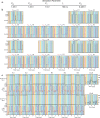Stateful Three-Input Logic with Memristive Switches
- PMID: 31602003
- PMCID: PMC6787102
- DOI: 10.1038/s41598-019-51039-6
Stateful Three-Input Logic with Memristive Switches
Abstract
Memristive switches are able to act as both storage and computing elements, which make them an excellent candidate for beyond-CMOS computing. In this paper, multi-input memristive switch logic is proposed, which enables the function X OR (Y NOR Z) to be performed in a single-step with three memristive switches. This ORNOR logic gate increases the capabilities of memristive switches, improving the overall system efficiency of a memristive switch-based computing architecture. Additionally, a computing system architecture and clocking scheme are proposed to further utilize memristive switching for computation. The system architecture is based on a design where multiple computational function blocks are interconnected and controlled by a master clock that synchronizes system data processing and transfer. The clocking steps to perform a full adder with the ORNOR gate are presented along with simulation results using a physics-based model. The full adder function block is integrated into the system architecture to realize a 64-bit full adder, which is also demonstrated through simulation.
Conflict of interest statement
The authors declare no competing interests.
Figures







References
-
- Frank D, et al. Device scaling limits of Si MOSFETs and their application dependencies. Proceedings of the IEEE. 2001;89:259–288. doi: 10.1109/5.915374. - DOI
-
- Williams RS. What’s Next? [The end of Moore’s law] Computing in Science & Engineering. 2017;19:7–13. doi: 10.1109/MCSE.2017.31. - DOI
-
- ITRS, International Technology Roadmap for Semiconductors 2.0 - 2015 Edition (2015).
-
- Kautz W. Cellular Logic-in-Memory Arrays. IEEE Transactions on Computers C. 1969;18:719–727. doi: 10.1109/T-C.1969.222754. - DOI
LinkOut - more resources
Full Text Sources

